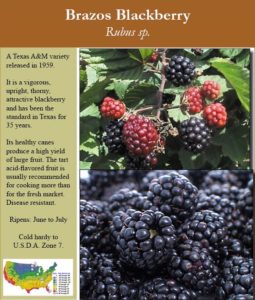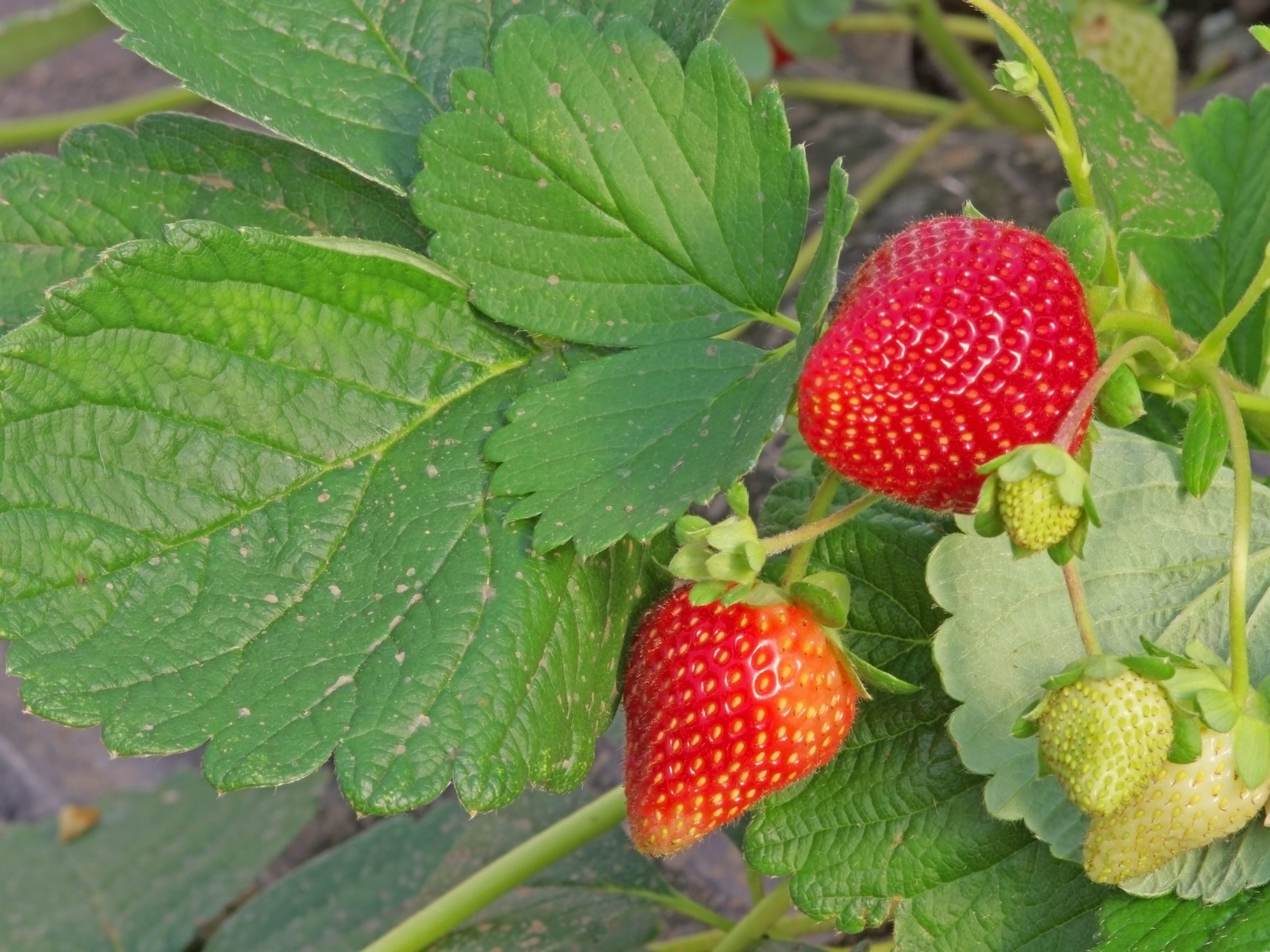Most Blackberries are biennials that produce their fruit the second year after planting. Some new introductions from the University of Arkansas called “Prime-Ark” Blackberries have the ability to produce on both the current year’s canes and the previous year’s canes. Blackberries do well in sandy soils, and can be grown in soils that are at least one foot deep with good drainage. In areas with poor drainage, they may be grown in raised beds.
You can choose from three different categories of blackberries to grow in Texas:
Thorny varieties are generally more productive than the thornless varieties. Most of the varieties with thorns were developed in Texas.
- ‘Brazos’ is an old, reliable and tough variety, developed at Texas A&M in 1950. It bears well for many years and the acidic fruit is better for cooking and canning. It is drought and heat tolerant, and has thorns.

- ‘Kiowa’: This Arkansas variety bears the largest fruit of any variety. It is a top-performing variety for Texas, producing good yields of large, high quality berries and has an erect habit. It requires 200 chilling hours.
- ‘Rosborough’: Another Texas A&M variety, released in 1977, it is the best early variety for South Central Texas. Its large fruit is sweeter than ‘Brazos’, and yields are often higher. It has an erect habit
Thornless varieties have been developed by the University of Arkansas, and are given Native American names. They are easier to work with and can bear tasty fruit.
- ‘Apache’: Bears large, sweet fruit, but yields have been variable. Plants are quite vigorous. Requires 800 chilling hours.

- ‘Arapaho’: Very productive and produces a medium sized fruit over a 4-week season. Erect growth habit. Establishes a dense hedgerow quickly. Resistant to double blossom and orange rust. Requires 500 hours chilling hours. Zone 8 suitable. Requires 500 chilling hours.
- ‘Natchez’: Good production and large fruit make this a promising variety. Requires 500 chilling hours.

- ‘Ouchita’: Berries mature mid-season with heavy yields and firm berries. Large fruit. Requires 300 chilling hours.
- ‘Triple Crown’: Interesting free-standing upright habit. Produces large sweet fruit over a 4-5 week period. May grow to 8’x4’. Biennial canes. Ripens mid-summer.
Primocane-bearing varieties are relatively new to the trade, but have been gaining popularity for their potential for producing two crops a year. Some are thornless, but there are also thorned varieties. These have been produced at the University of Arkansas.
- ‘Prime-Ark Freedom’: This is a thornless variety with nice-sized fruit. It sets fruit on primocanes August to September, and on 1-year-old floricanes in May and June. It is better adapted to hot climates.
- ‘Prime-Ark Traveler’: A thornless variety with high yields released by the University of Arkansas. It has med-large fruit that is sweet and has low acidity. First-year canes ripen in July and second-year canes ripen in June.
- ‘Prime-Ark 45’: This thorned variety was also produced by the Univ. of Arkansas and boasts erect canes with easy to harvest medium sized fruit. The firm berries have excellent storage life. The first and second year canes produce over an extended harvest period beginning in June.
Culture
Plant blackberries 2’-3’ apart in rows about 12’ apart.
Irrigation is essential to produce quality fruit. Begin watering in March or April, using drip irrigation, if possible, to avoid wetting the leaves. Water well during bloom and fruit set, and as fruit is ripening. Continue watering regularly through September when you will begin to reduce frequency of watering to “harden off” the canes. Winter irrigation may be necessary if the winter is dry.
Control weeds with a mulch of wood chips and using a pre-emergent labeled for use with fruit bearing plants to prevent weed seeds from germinating. Excess weeds compete for water and nutrients and make harvesting difficult. A weed barrier fabric may be used, but must not cover the center of the blackberry row, as new primocanes must be allowed to emerge. Selective chemical herbicides may be used to control grass in blackberry plantings.
Fertilize blackberries first when they begin to leaf-out, then again in the summer after the fruit has been harvested. Nitrogen is the most important nutrient for blackberries, although other nutrients may be deficient at times, too. Have soil tested every 3 years to determine nutrients needed.
Trellising: Most varieties of blackberries grown in Texas have an “erect or semi-erect” growth habit. When the floricanes are loaded down with fruit, the canes will bend over and touch the ground. There is a risk for fruit decay if the fruits come in contact with the ground.
Blackberries may be trellised, planted near a fence or left alone. A simple two-wire trellis with horizontal wires at 30” and 60” will provide support that is easy to work with. Keeping the canes up off the ground will make weed control easier. Tip-pruning regularly can prevent the canes from growing too long and encourages shorter, branched floricanes to form.
The newer “Prime Ark” varieties are more erect in their growth habit and do not require trellising.
Pruning:
Pruning is necessary to maintain an orderly bed and to reduce disease. We have covered pruning in a separate blog. See Blackberry Pruning HERE .






